Abstract
OBJECTIVE: To carry out a comprehensive field investigation to evaluate various conventional and recently developed biomarkers for exposure to low concentrations of benzene. METHODS: Analyses were carried out on environmental air, unmetabolised benzene in blood and urine, urinary trans, transmuconic acid, and three major phenolic metabolites of benzene: phenol, catechol, and hydroquinone. Validations of these biomarkers were performed on 131 never smokers occupationally exposed to the time weighed average benzene concentration of 0.25 ppm (range, 0.01 to 3.5 ppm). RESULTS: Among the six biomarkers studied, unmetabolised benzene in urine correlated best with environmental benzene concentration (correlation coefficient, r = 0.76), followed by benzene in blood (r = 0.64). When urinary metabolites were compared with environmental benzene, trans, trans-muconic acid showed a close correlation (r = 0.53) followed by hydroquinone (r = 0.44), and to a lesser extent with urinary phenol (r = 0.38). No correlation was found between catechol and environmental benzene concentrations. Although unmetabolised benzene in urine correlates best with benzene exposure, owing to serious technical drawbacks, its use is limited. Among the metabolites, trans, trans-muconic acid seems to be more reliable than other phenolic compounds. Nevertheless, detailed analyses failed to show that it is specific for monitoring benzene exposures below 0.25 ppm. CONCLUSION: The overall results suggest that most of the currently available biomarkers are unable to provide sufficient specificity for monitoring of low concentrations of benzene exposure. If a lower occupational exposure limit for benzene is to be considered, the reliability of the biomarker and the technical limitations of measurements have to be carefully validated.
Full text
PDF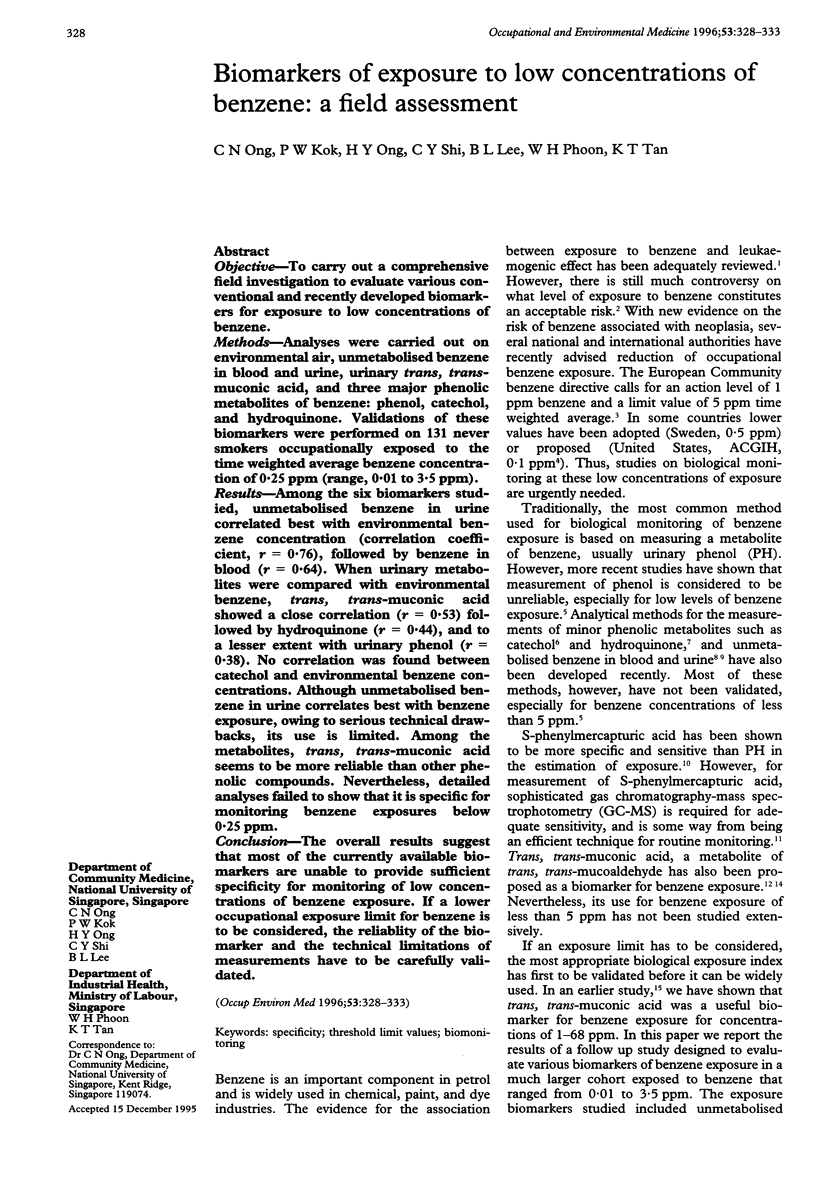
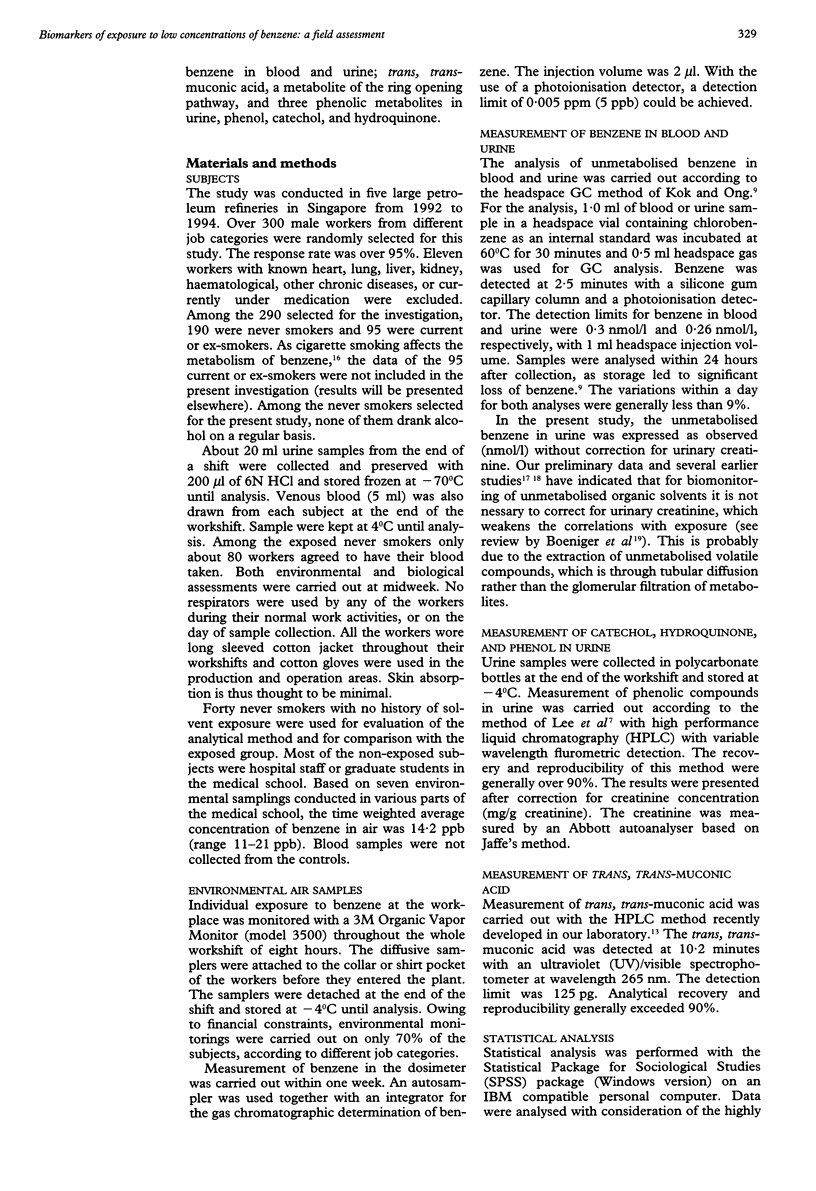
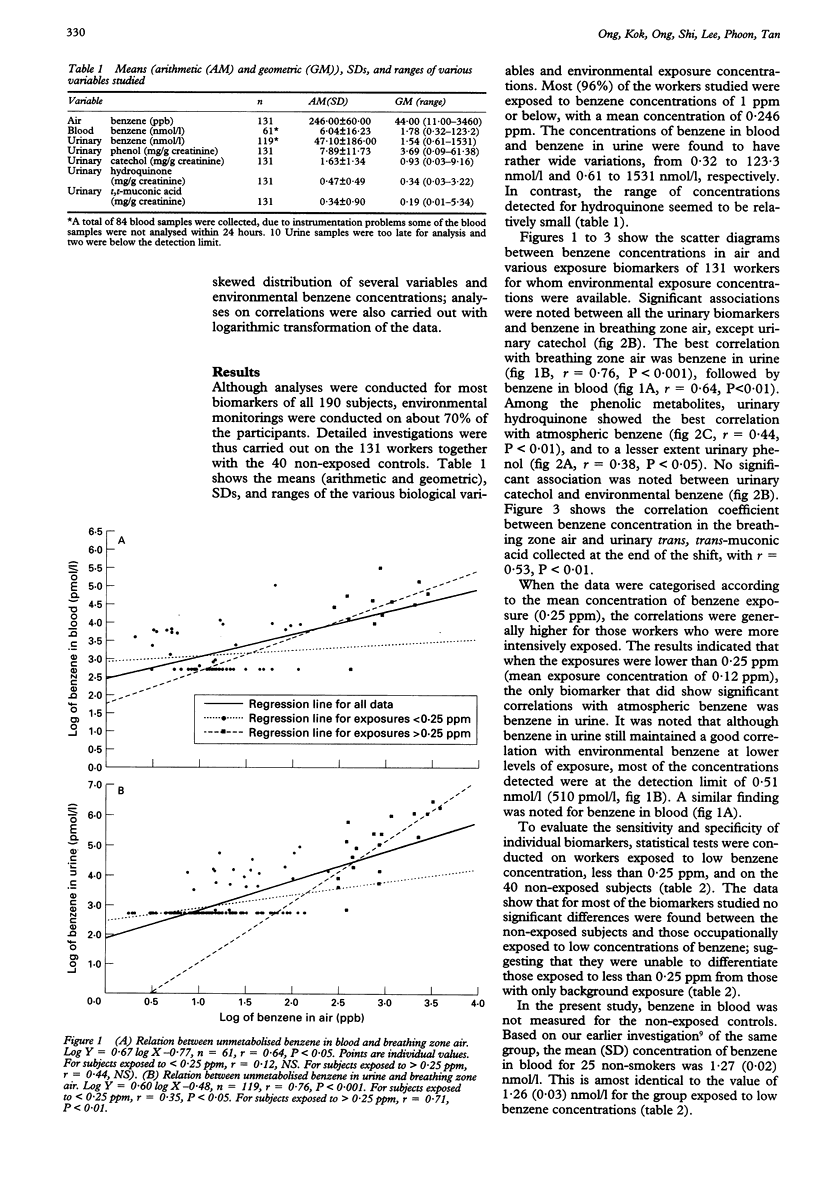
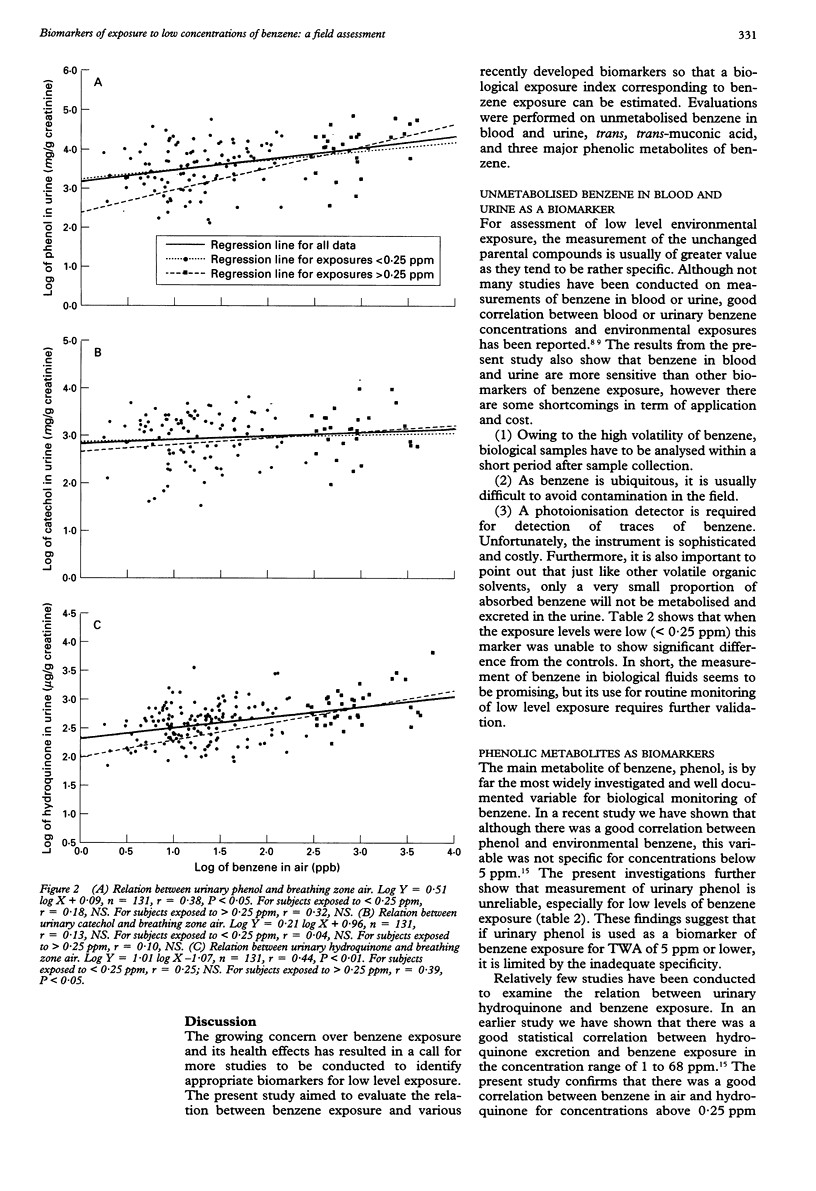
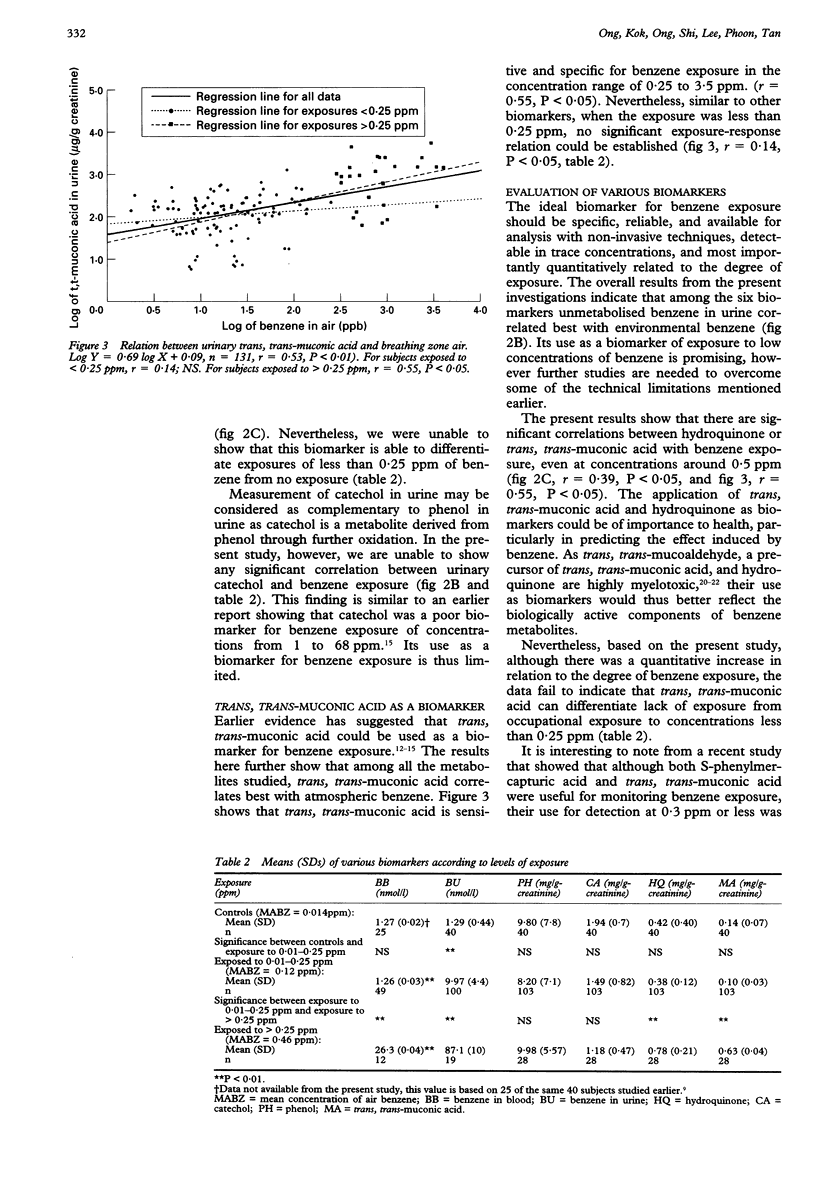
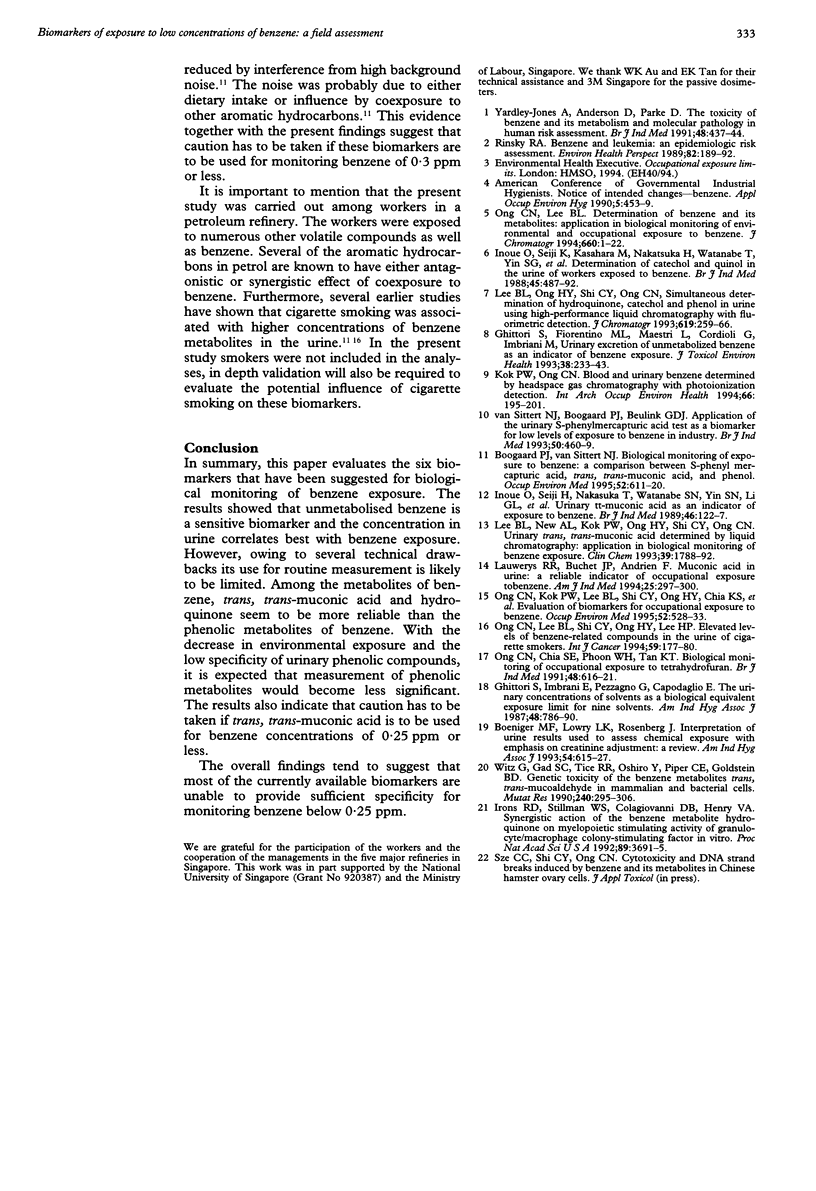
Selected References
These references are in PubMed. This may not be the complete list of references from this article.
- Boeniger M. F., Lowry L. K., Rosenberg J. Interpretation of urine results used to assess chemical exposure with emphasis on creatinine adjustments: a review. Am Ind Hyg Assoc J. 1993 Oct;54(10):615–627. doi: 10.1080/15298669391355134. [DOI] [PubMed] [Google Scholar]
- Boogaard P. J., van Sittert N. J. Biological monitoring of exposure to benzene: a comparison between S-phenylmercapturic acid, trans,trans-muconic acid, and phenol. Occup Environ Med. 1995 Sep;52(9):611–620. doi: 10.1136/oem.52.9.611. [DOI] [PMC free article] [PubMed] [Google Scholar]
- Ghittori S., Fiorentino M. L., Maestri L., Cordioli G., Imbriani M. Urinary excretion of unmetabolized benzene as an indicator of benzene exposure. J Toxicol Environ Health. 1993 Mar;38(3):233–243. doi: 10.1080/15287399309531715. [DOI] [PubMed] [Google Scholar]
- Ghittori S., Imbriani M., Pezzagno G., Capodaglio E. The urinary concentration of solvents as a biological indicator of exposure: proposal for the biological equivalent exposure limit for nine solvents. Am Ind Hyg Assoc J. 1987 Sep;48(9):786–790. [PubMed] [Google Scholar]
- Inoue O., Seiji K., Kasahara M., Nakatsuka H., Watanabe T., Yin S. G., Li G. L., Cai S. X., Jin C., Ikeda M. Determination of catechol and quinol in the urine of workers exposed to benzene. Br J Ind Med. 1988 Jul;45(7):487–492. doi: 10.1136/oem.45.7.487. [DOI] [PMC free article] [PubMed] [Google Scholar]
- Inoue O., Seiji K., Nakatsuka H., Watanabe T., Yin S. N., Li G. L., Cai S. X., Jin C., Ikeda M. Urinary t,t-muconic acid as an indicator of exposure to benzene. Br J Ind Med. 1989 Feb;46(2):122–127. doi: 10.1136/oem.46.2.122. [DOI] [PMC free article] [PubMed] [Google Scholar]
- Irons R. D., Stillman W. S., Colagiovanni D. B., Henry V. A. Synergistic action of the benzene metabolite hydroquinone on myelopoietic stimulating activity of granulocyte/macrophage colony-stimulating factor in vitro. Proc Natl Acad Sci U S A. 1992 May 1;89(9):3691–3695. doi: 10.1073/pnas.89.9.3691. [DOI] [PMC free article] [PubMed] [Google Scholar]
- Kok P. W., Ong C. N. Blood and urinary benzene determined by headspace gas chromatography with photoionization detection: application in biological monitoring of low-level nonoccupational exposure. Int Arch Occup Environ Health. 1994;66(3):195–201. doi: 10.1007/BF00380780. [DOI] [PubMed] [Google Scholar]
- Lauwerys R. R., Buchet J. P., Andrien F. Muconic acid in urine: a reliable indicator of occupational exposure to benzene. Am J Ind Med. 1994 Feb;25(2):297–300. doi: 10.1002/ajim.4700250216. [DOI] [PubMed] [Google Scholar]
- Lee B. L., New A. L., Kok P. W., Ong H. Y., Shi C. Y., Ong C. N. Urinary trans,trans-muconic acid determined by liquid chromatography: application in biological monitoring of benzene exposure. Clin Chem. 1993 Sep;39(9):1788–1792. [PubMed] [Google Scholar]
- Lee B. L., Ong H. Y., Shi C. Y., Ong C. N. Simultaneous determination of hydroquinone, catechol and phenol in urine using high-performance liquid chromatography with fluorimetric detection. J Chromatogr. 1993 Sep 22;619(2):259–266. doi: 10.1016/0378-4347(93)80115-k. [DOI] [PubMed] [Google Scholar]
- Ong C. N., Chia S. E., Phoon W. H., Tan K. T. Biological monitoring of occupational exposure to tetrahydrofuran. Br J Ind Med. 1991 Sep;48(9):616–621. doi: 10.1136/oem.48.9.616. [DOI] [PMC free article] [PubMed] [Google Scholar]
- Ong C. N., Kok P. W., Lee B. L., Shi C. Y., Ong H. Y., Chia K. S., Lee C. S., Luo X. W. Evaluation of biomarkers for occupational exposure to benzene. Occup Environ Med. 1995 Aug;52(8):528–533. doi: 10.1136/oem.52.8.528. [DOI] [PMC free article] [PubMed] [Google Scholar]
- Ong C. N., Lee B. L. Determination of benzene and its metabolites: application in biological monitoring of environmental and occupational exposure to benzene. J Chromatogr B Biomed Appl. 1994 Oct 3;660(1):1–22. doi: 10.1016/0378-4347(94)00278-9. [DOI] [PubMed] [Google Scholar]
- Ong C. N., Lee B. L., Shi C. Y., Ong H. Y., Lee H. P. Elevated levels of benzene-related compounds in the urine of cigarette smokers. Int J Cancer. 1994 Oct 15;59(2):177–180. doi: 10.1002/ijc.2910590206. [DOI] [PubMed] [Google Scholar]
- Rinsky R. A. Benzene and leukemia: an epidemiologic risk assessment. Environ Health Perspect. 1989 Jul;82:189–191. doi: 10.1289/ehp.8982189. [DOI] [PMC free article] [PubMed] [Google Scholar]
- Witz G., Gad S. C., Tice R. R., Oshiro Y., Piper C. E., Goldstein B. D. Genetic toxicity of the benzene metabolite trans, trans-muconaldehyde in mammalian and bacterial cells. Mutat Res. 1990 Apr;240(4):295–306. doi: 10.1016/0165-1218(90)90080-l. [DOI] [PubMed] [Google Scholar]
- Yardley-Jones A., Anderson D., Parke D. V. The toxicity of benzene and its metabolism and molecular pathology in human risk assessment. Br J Ind Med. 1991 Jul;48(7):437–444. doi: 10.1136/oem.48.7.437. [DOI] [PMC free article] [PubMed] [Google Scholar]
- van Sittert N. J., Boogaard P. J., Beulink G. D. Application of the urinary S-phenylmercapturic acid test as a biomarker for low levels of exposure to benzene in industry. Br J Ind Med. 1993 May;50(5):460–469. doi: 10.1136/oem.50.5.460. [DOI] [PMC free article] [PubMed] [Google Scholar]


